Remember the neat tidy solar system of the 20th century? As a child of the 1970s, we remember orderly planets, with circular orbits punctuated by the occasional asteroid or comet. They say ignorance is bliss, and the modern astronomical age of discovery in the 21st century has since revealed a cosmic terra incognita in our solar backyard.
We’re talking about the 99% of the solar system by volume out beyond the orbit Neptune, occupied by Trans-Neptunian Objects (TNO), Plutinos (the object, not the drink), Kuiper Belt Objects (KBOs) and more.
136108 Haumea — one of the strangest worlds of them all — was introduced into the solar system menagerie about ten years ago. Discovered by Mike Brown (@Plutokiller extraordinaire) and team in late December 2004 from the Palomar Observatory, Haumea (say HOW-meh) received its formal name on September 17, 2008 along with its dwarf planet designation. Remember, astronomers discovered Haumea — like Xena turned Eris — before the series of decisions by the International Astronomical Union in 2006 which led to the Pluto is a planet/is a dwarf planet/ is a Plutoid roller coaster ride.
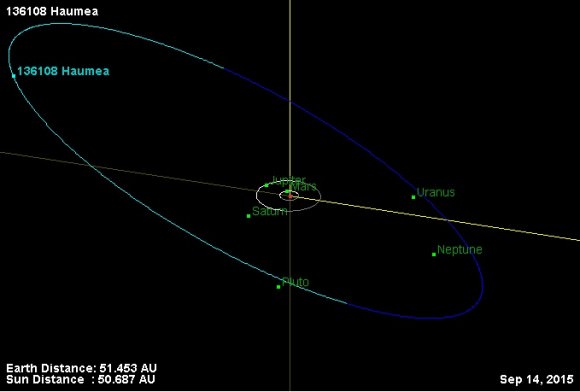
You’ve come a long way, little ice world, as New Horizons has finally given us a view of Pluto and friends just this past summer. Thankfully, most of us weren’t on Twitter yet back in 2006… heck, you can even read the original article by Universe Today from around the time of Eris and Haumea’s discovery (really: we’ve been around that long!)
It wasn’t long before Brown and team realized they had a strange discovery on their hands, as well as a lingering controversy. First, a team from the Sierra Nevada Observatory in Spain attempted to scoop the Palomar team concerning the discovery. It was later learned that the Sierra Nevada team was accessing the Caltech logs remotely, and looking at where the telescopes were hunting in the sky, and at what times. Though the Spanish team later conceded accessing the observation logs, they maintained that they were double-checking earlier observations of the subject object from 2003. Wherever you stand on the discovery hullabaloo, Mike Brown goes into depth on the modern astronomical controversy in his book How I Killed Pluto and Why it Had it Coming.
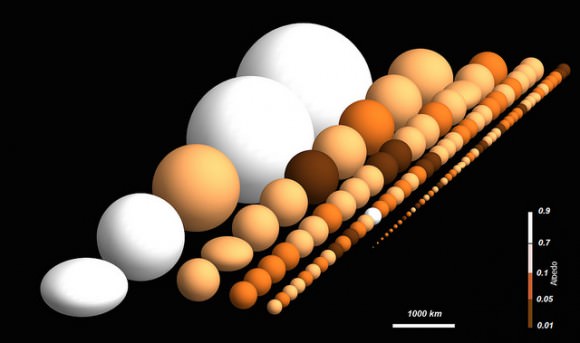
Haumea initially earned the nickname ‘Santa Claus’ due to its discovery near the Christmas holiday. Haumea derives its formal name from the Hawaiian goddess of childbirth. Likewise, the reindeer inspired moons Rudolph and Blitzen were later named Hi’aka and Namaka after daughters of Haumea in the Hawaiian pantheon. Brown at team discovered both moons shortly after Haumea itself.
A Bizarre World
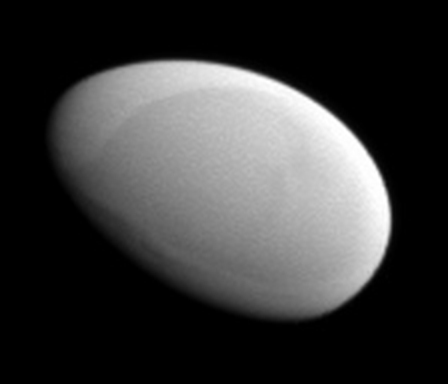
The Bizzaro homeworld of Superman mythos has nothing on Haumea. OK, maybe it’s not a perfect cube — remember, nothing’s perfect on the Bizzaro planet either — but it does have a decidedly oblate egg shape. Haumea is a fast rotator, with a ‘day’ equal to about four hours. We know this due to periodic changes in brightness. Haumea also has a high albedo of about 80%, similar to freshly fallen snow.
Models suggest that Haumea is about twice as long as it is wide, with dimensions of 2,000 kilometres along its long axis, versus 1,000 kilometres through its poles. The presence of two tiny moons allows us to estimate its mass at about 33% of Pluto, and 6% that of Earth’s Moon. With such a fast rotation, Haumea must just be barely maintaining hydrostatic equilibrium, though it’s stretching the world to its max.
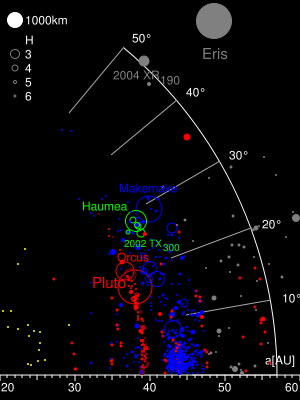
Evidence of an ancient collision, perhaps? It would be fascinating to see Haumea up close. Like Pluto, however, it’s distant, with an aphelion near 51.5 AU and a perihelion near 35 AU. Orbiting the Sun once every 284 years, Haumea just passed aphelion in 1992 about a decade prior to discovery, and perhaps the time to send a New Horizons-type mission past it would be near perihelion in 2134. Interestingly, Haumea is also in a near 7:12 resonance with Neptune, meaning it completes 7 orbits around the Sun to Neptune’s 12.
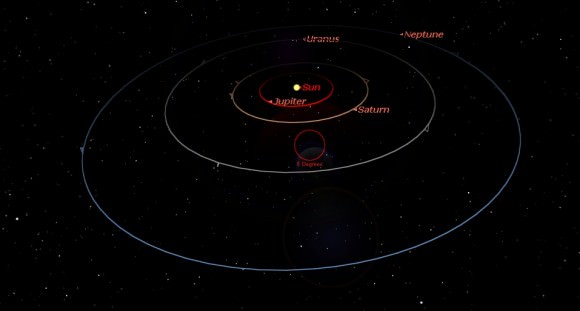
A Swift Sky
Astronomy from Haumea is literally dizzying to contemplate. First, prepare yourself for that four hour day: you would easily see the rotation of the sky — to the tune of an object rising and reaching the zenith in just an hour — moving in real time. Then there’s the two moons Namaka and Hi’iaka, in 18 and 50 day orbits, respectively… both would show discernible discs and phases courtesy of the Sun, which would currently present a 38” disk shining at magnitude -18 (still about 100 times brighter than a Full Moon). Looking for Earth? It’s an easy catch at magnitude +4.8 but never strays more than 1 degree from the Sun, twice the diameter of a Full Moon.
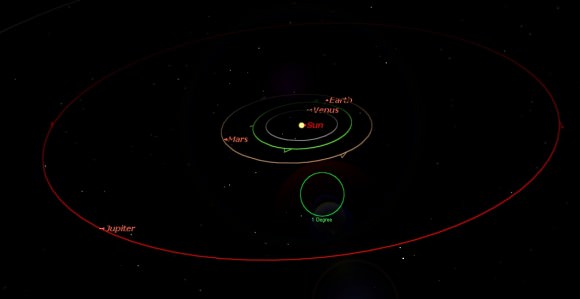
Haumea currently shines at magnitude +17 in the constellation Boötes. Theoretically, it’s within the grab of a large amateur telescope, though to our knowledge, no backyard observer has ever manage to nab it… perhaps this will change over the next century or so towards perihelion?
Scratch that… we’ve since learned that Mike Weasner did indeed nab Haumea in 2013 from his backyard Cassiopeia observatory near Oracle, Arizona:

Awesome!
The discovery of Haumea and friends is a fascinating tale of modern astronomy, and shows us just how strange the brave new worlds of the outer solar system are. Perhaps one day, human eyes will gaze at the bizarre skies of Haumea… though keeping a telescope tracking might be a true challenge!


Now why do they always portray this object as a perfectly smooth egg? Seriously, no object can be so smooth and crater free. At least add a few pock marks on it!
I have never seen the shot presented of Meth-one. so smooth. looks like something I cracked open for breakfast this morning…
Chris 😉
It’s high albedo suggests it’s very reflective and smooth. Remember, it’s spinning so fast it’s being stretched out like a tubular pizza dough closed on both sides. And it also mentioned it’s rotating so fast it’s barely holding together which also plays into it’s smoothness per molten and constantly resurfaced because of tidal pressure? Or simply because it’s stretched to it’s tensile limit?
José Luis Ortiz Moreno seems like an honorable man, and I see no reason to favor Brown’s side of the story over his. Just because Brown wrote about this matter in the same book in which he absurdly claims to have killed Pluto is no reason to favor his and his team’s claim, nor to shamelessly plug his absurdly-titled book.
Ortiz never publicly beheaded a doll of Pluto the Dog. Ortiz never has claimed to be the sole discoverer of Eris and Sedna. Ortiz is not an attention-addicted narcissist. Moreover, the IAU has not taken sides on this issue. The matter is not closed just because Brown says it is. His credibility regarding discoveries is pretty dismal. Why don’t you ask Chad Trujilllo and David Rabinowitz, the co-discoverers of Eris, what they think about Brown’s claim that he killed Pluto. That implies he was the sole discoverer of Pluto. Brown never corrects interviewers, either, when they say he discovered Eris. It is disturbing.
Haumea/Ataecina deserves better than this. It should also be the next planet we explore.
They’re rocks in space. Why do people anthropomorphise them to the point of attributing feeling a sense of pity for it over nothing it could ever be aware of for many reasons. Not the least of which it that… they’re hunks of rocks in space. Science needs to try and keep things tidy per classifying them… only it usually makes them more complicated. Think of someone in the 1800’s with many many wooden drawered boxes all over his shelves. Of many sizes and arranged into cabinets based on topic and so on….. Same thing. It’s just gonna happen. Be the larger of the two sides and just stop complaining about the inevitable. No one will give a hell about it in 50 years one way or the other. (theydon’t/can’tknow) 😉
The IAU resolution and Brown’s “Pluto is dead” nonsense are anything but “inevitable.” The former is a poor classification system, and the latter is simply a sensationalizing, self-promoting PR stunt by Brown.
Advocating a better classification system does not constitute “anthropomorphizing” celestial objects. That accusation is yet another straw man argument used by supporters of the IAU decision.
No one should stop advocating for a better classification system–one actually created by planetary scientists–and a discussion of dwarf planets that does not sound like an attempt to sell one person’s book. I know I certainly will not do that.
As for whether people will care about this in 50 years, nobody can know that though it is reasonable to suspect there will be many more types of planets discovered by then that will completely reframe the discussion.
There is a launch window coming up as well if we hustle. The problem is, Haumea probably looks like that in person too. It’s probably got a really young surface covered with fresh snow. After Pluto everyone’s going to want their money back when they see the high res Haumea close ups!
I’m not sure if New Horizons was a prototype for more missions, or a hail Mary. It worked out extremely well. But we need a breakthrough tech that’s going to get the mass down and the delta V up. We need to be able to slow down once we get there, this is a major problem even with Mars. This should be an urgent priority if we are not content to just scratch the surface. We should spend the money on R&D.
Regarding Pluto nomenclature, I sent my money to Uwingu and was granted naming rights, so all of this is moot. The ninth planet is heretofore named Crocodilebomb.
croc
Per Wikipedia:
It was calculated that a flyby mission to Haumea/Ataecina could take 14.25 years using a Jupiter gravity assist, based on a launch date of 25 September 2025. Haumea/Ataecina would be 48.18 AU from the Sun when the spacecraft arrives. A flight time of 16.45 years can be achieved with launch dates on 1 November 2026, 23 September 2037 and 29 October 2038.[62]
McGranaghan, R.; Sagan, B.; Dove, G.; Tullos, A.; Lyne, J. E.; Emery, J. P. (2011). “A Survey of Mission Opportunities to Trans-Neptunian Objects”. Journal of the British Interplanetary Society 64: 296–303.
I hope we launch sooner than 2025. Team New Horizons wants to analyze all its data before pondering future missions, probably. But that will be done well before 2025.
Awesome; thanks for the info. A ‘Haumea flyby mission’ isn’t on NASA’s shortlist for the coming decade yet, but perhaps it should be. there’s obviously something very intriguing going on there.
That egg shape.. We’ve seen dual lobed asteroids before. Imagine one of those suckers with a 2 billion year old accumulation of stellar and interstellar dust and ice particles. The particles attracted by gravity and triboelectric ground charges as generated by passing solar plasmas. Otherwise.. it looks like a stone that’s been rounded by tumbling along the shore or on the bottom in a swift moving stream.
Indeed, it does, Aqua. It would be nice if we could see Ataecina before I die. I am 54 now. A gypsy in Alphabet City said I would live another 30 years or so. Maybe 35. The next President better be into space exploration or we should have a coup.
Could we please have a discussion of dwarf planets without a commercial for Brown’s book and/or the constant reference to him as “Plutokiller?” There is no “extraordinaire” because he did not kill planet Pluto, which is very much alive, both in terms of the planet debate and geologically, as shown by New Horizons. The entire “Plutokiller” thing is unprofessional and misleading, and serious astronomy sites like Universe Today should not endorsing it or constantly repeating it.
Interestingly, Rabinowitz, a co-discoverer of Eris, signed a formal petition rejecting the IAU planet definition and demotion of Pluto.
Why not seek Ortiz’s perspective on Haumea’s discovery for the sake of presenting a fair and balanced account? How do you know his team did not discover it first?
If you are going to promote books about Kuiper Belt Objects, at least provide a list reflecting a variety of viewpoints instead of just promoting one view and one side. Brown’s book is not even a genuine astronomy book; it is a memoir in which about one third of the content is about his personal life, which many readers find of little interest.
How about mentioning Alan Boyle’s book “The Case for Pluto,” or Laurence A. Marschall and Steven Maran’s book “Pluto Confidential?” Why not refer people to the Twitter accounts of @NewHorizons2015, @B0yle , @AlanStern, and @plutosavior?
It’s simply a naming reclassification. It in no way is meant to snub and thus hurt the feelings of this non living collection of fascinating geology.
Objection to the constant promotion of Brown has nothing to do with feelings or claims that celestial objects have feelings. That is a straw man argument used repeatedly against those who oppose the IAU definition. Our opposition is based on support for the geophysical rather than dynamical planet definition, which focuses on what an object is rather than on where it is. Many in the planetary science community view the geophysical definition as a scientifically superior classification system. The different types of planets can be distinguished using subcategories such as terrestrial planet, gas giant, ice giant, dwarf planet, hot Jupiter, super Earth, hot Neptune, rogue planet, etc.
Opposition to the constant promoting of Brown and his book is based on a desire for fair and balanced journalism that presents both sides and refrains from incessantly promoting the merchandise of one person to the point that article appear more like PR messages designed to sell that merchandise rather than to educate and inform people about the subject. This can be easily remedied by suggesting a list of books, websites, and Twitter feeds by a variety of writers representing a diversity of perspectives on the issue.
“Thankfully, most of us weren’t on Twitter yet back in 2006…”
thankfully most of you weren’t on twitter yet back in 2006 🙂
imagine they had left it as “Santa Claus”… damn, I would have loved that. Haumea is an okay name though… although spellcheck seems to not like it much. c’mon spellcheck.. get with the trans-Neptunian times!
“How I Killed Pluto & Why it Had it Coming”
Laurel, are you reading this? if so, you better sharpen the pitch forks and bust out the torches… because we have a long night ahead of us!
It is not about feelings. It is about proper classification and consistency. Why are dwarf stars also stars? Why are dwarf galaxies also galaxies. Why are dwarf cashews also cashews. Yet dwarf planets are not planets? Why is it that world-renowned planetary scientists like Dr. Alan Stern and Dr. David Rabinowitz support the replanetizaton of Pluto? The case for replanetization is very strong. Why, lastly, is Mercury still a planet? Ganymede and Titan are larger than Mercury.
Ganymede and Titan left their old orbits and are now orbiting around the Sun? That’s some big news.
He means satellite planets. There is a case to be made that moons large enough to be in hydrostatic equilibrium (rounded by their own gravity), which have the same complex structures and processes as the terrestrial planets–should be considered secondary or satellite planets.
Also, some argue that Pluto cannot be a planet because it is smaller than seven large solar system moons. By that logic, Mercury should not be considered a planet either since it is smaller than Ganymede and Titan.
I’m gonna write a book How I scientifically disproved Laurele and Wrathell and why they are so annoying.
Is that ok, dear authors? I’m not from Islamic state, I’m not gonna hurt anybody. It’s not a threat. Is writting a book about someone a threat?
laurele, you go girl, planets will be moons and moons will be planets. 😀
Lubomir, can you please refrain from making ad-hominem comments on Universe Today? It doesn’t push the conversation forward in any way. Seriously, can’t we have one place on the internet where people are polite to each other?
A lot of armchair scientists in here. Many of the world’s leading planetary scientists think dwarf planets should be a subcategory of planets. The majority of the IAU’s members are not planetary scientists. Even Mike Brown, when he first co-discovered Eris, told his wife he discovered a planet. And as far as being emotional about Pluto, he once publicly decapitated a Disney Pluto doll, and the title of his book betrays an emotionally unbalanced position on Pluto, as well. Also, he never corrects interviewers when they say he discovered Eris, which is very insulting to Chad Trujillo and David Rabinowitz. It seems he is very emotionally invested in the demotion of Pluto and it is intricately tied to his ego.